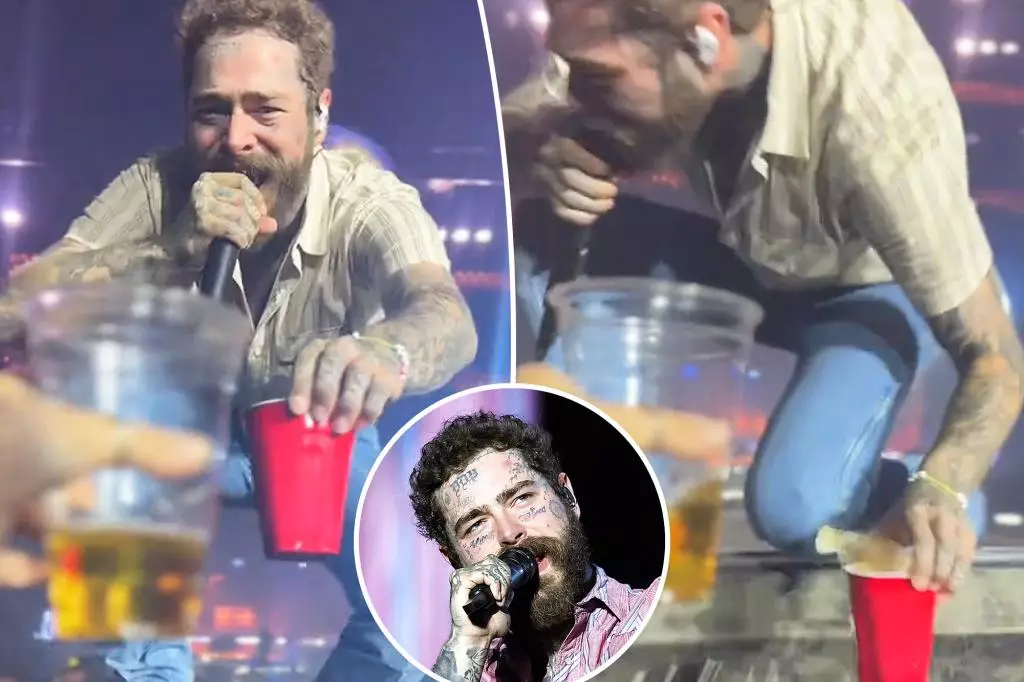Live performances are inherently unpredictable, and even the most seasoned artists are not immune to accidents on stage. Post Malone’s recent falls—once during a toast with a fan and previously after stepping into a hidden stage hole—highlight how fragile the illusion of control is in a live setting. These incidents underscore the unpredictable nature of stagecraft, where spontaneity can turn into danger in a matter of seconds. Live shows are a testament to the artist’s ability to adapt and persevere amidst chaos, and Post Malone’s incidents serve as stark reminders that even global stars face vulnerability when in the spotlight.
While fans often idealize performers as invincible icons, the truth reveals a more human side—one that requires resilience and exceptional mental toughness. Malone’s attempts to connect with fans through personal moments, like raising a drink mid-song, are part of his charm but also introduce risks that artists accept as part of crafting an authentic experience. Nonetheless, these accidents reveal a significant challenge in stage safety management, emphasizing the importance of rigorous infrastructure checks and innovative stage design that prioritizes performer safety without compromising artistic spontaneity.
Sympathy and Admiration: The Human Side of Fame
The reactions following Malone’s falls evoke a complex mixture of concern and admiration. Fans’ sympathetic comments, like questioning his well-being and expressing fears that the incidents would haunt him, reflect our collective empathy towards performers who often appear larger than life. Their willingness to show genuine care demonstrates that despite the fame and wealth, celebrities are deeply human—vulnerable to the same risks and emotional responses as anyone else.
More compelling is the way Malone handles these moments with grace. After the stage hole incident, he addressed his audience with humor and gratitude, reinforcing his authenticity. When he reassured fans that he’d received medical treatment and was doing well, it created a sense of shared resilience. His openness fosters a connection that transcends mere entertainment, painting him as a relatable figure who endures discomfort and danger to deliver memorable moments on stage.
This honesty not only fortifies fans’ admiration but also humanizes a superstar often overshadowed by his maintained persona of cool detachment. Malone’s attitude exemplifies an essential aspect of true resilience: acknowledging adversity without succumbing to fear or shame, inspiring fans to confront their own setbacks with a similarly brave outlook.
Lessons in Preparedness and Adaptability for Artists and Promoters
Malone’s accidents cast a spotlight on the importance of meticulous planning in live event production. The design of stage structures and safety measures plays a crucial role in safeguarding performers. The repetitive nature of these incidents suggests systemic flaws—whether in stage design, risk assessment, or operational oversight—that demand critical evaluation.
For touring artists and promoters, these episodes should serve as wake-up calls. Ensuring stage safety involves proactive measures—thorough inspections, employing safer stage layouts, and integrating fail-safes for unpredictable moments. Malone’s fall from the stage led to physical injuries, but it could have been far worse. These incidents highlight that no matter how talented or experienced an artist may be, constant vigilance and innovation are necessary to prevent avoidable accidents.
Moreover, these events demonstrate the importance of mental resilience—not only for performers but also for the production teams behind the scenes. A performer’s capacity to continue despite setbacks exemplifies the kind of grit required to thrive in the demanding world of touring. In a broader sense, the industry must foster a culture prioritizing safety through proper infrastructure and prompt response protocols, ensuring that the thrill of live performance does not come at an unacceptable cost.
On the Broader Impact: Redefining the Notion of “Celebrity Vulnerability”
Post Malone’s recent misadventures challenge societal perceptions of celebrity invincibility. Every fall reveals that behind the glitz is a person facing physical and emotional risks. These moments humanize him and remind us that fame does not exempt individuals from human vulnerabilities. Rather than diminishing his stature, these incidents can deepen fans’ appreciation by showcasing his resilience and transparency.
Furthermore, Malone’s candid responses—addressing his injuries and expressing gratitude—set a powerful precedent for openness in the music industry. It signals that vulnerability, when met with humility and humor, can foster a stronger bond between performer and audience. He refuses to let mishaps define him negatively; instead, he embraces them as part of his journey. This attitude not only inspires fans but also encourages other artists to acknowledge their own challenges openly rather than hide behind manufactured perfection.
In a media landscape obsessed with perfection, Malone’s stance breaks the mold, emphasizing that genuine human experiences add depth and relatability. It prompts us to rethink the facade of celebrity perfection, recognizing that strength often lies in acknowledging weakness and pushing forward despite setbacks. His resilience is a testament to the enduring spirit of performers committed to their craft, regardless of the hurdles they encounter along the way.

